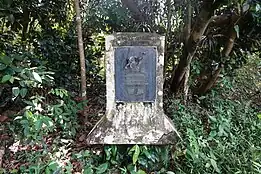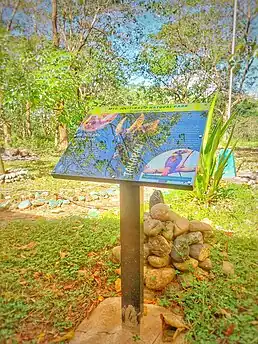| Mounts Iglit–Baco Natural Park | |
|---|---|
IUCN category IV (habitat/species management area) | |
_-_panoramio_(1).jpg.webp) Mount Iglit in Calintaan | |
.svg.png.webp) .svg.png.webp) | |
| Location | Mindoro, Philippines |
| Nearest town | Sablayan, Calintaan, Rizal and San Jose, Occidental Mindoro Bongabong, Bansud, Gloria, and Mansalay, Oriental Mindoro |
| Coordinates | 12°54′N 121°13′E / 12.900°N 121.217°E |
| Area | 106,655.62 hectares (263,551.8 acres) |
| Established | November 9, 1970; June 1, 1992; June 22, 2018 |
| Visitors | 322 (in November 2019 to February 2020) |
| Governing body | Department of Environment and Natural Resources |
The Mounts Iglit–Baco Natural Park (MIBNP) is a legislated protected area of the Philippines and an ASEAN Heritage Park located in the island of Mindoro in central Philippines. First established in 1970 by virtue of Republic Act No. 6148 as "National Park" that covers an area of 75,445 hectares (186428.65 acres) surrounding Mount Iglit and Mount Baco in the central interior of Mindoro[1]. The park is the home of the largest remaining population of the critically endangered Tamaraw. In 2003, the Association of Southeast Asian Nations listed it as one of its four heritage parks in the Philippines.[2] The park has also been nominated in the Tentative List of UNESCO World Heritage Sites in 2006.[3] In 2018, the park was designated as a “Natural Park” under the Republic Act No. 11038 or the Expanded National Integrated Protected Areas Systems (ENIPAS) Act of 2018 and increased the area to 106,655.62 hectares. [4]
Geography
.jpg.webp)
The natural park lies in the south-central area of Mindoro and is politically divided between the municipalities of Sablayan, Calintaan, Rizal and San Jose in Occidental Mindoro, and the municipalities of Bongabong, Bansud, Gloria, and Mansalay in Oriental Mindoro.[5] It has a rugged terrain composed of slopes, river gorges, mountains and plateaus. In the park's northern portion, Mount Baco rises to an elevation of 2,488 metres (8,163 ft) above sea level. Mount Iglit reaches 2,364 metres (7,756 ft) and can be found south of Mount Baco.[3] The park is crossed by ten major river systems, including Mongpong, Patrick, Mag-asawang tubig, Bongabong, Lamintao, Anahawin, and Busuanga Rivers which empty into the West Philippine Sea.
Socio-Economic and Cultural Profile

The park is home to at least six ethnic groups on the island: the Batangas, Tagalog, Mangyan, Bisaya, Bicolano, and Ilocano.[6] At least five (5) Mangyan groups, including 1) Bangon; 2) Buhid; 3) Hanunuo; 4) Tadyawan; and 5) TaoBuid, each with its own language, culture, and tradition. Moreover, the protected area shares boundaries with parts of the ancestral domains of the Taobuid, Buhid, and Bangon, with their unique and entwined cultures within MIBNP. These communities have nurtured a deep connection with the land for generations, their traditions and way of life entwined with the natural rhythms of the park.The Mangyans depend on the park for their subsistence, where they engage in traditional farming and hunting for food. There are also areas of grasslands turned into pastures, as well as areas of slash-and-burn "kaingin" agriculture.[6]
Biological Features
The park's vegetation consists primarily of grasslands, lowland Dipterocarp forests, and montane rainforests on the higher slopes. In the park's southern portion near the Lamintao River is a 367-hectare (910-acre) block of Acacia forest. There is also an area of Agoho forest along the Anahawin River within the Mindoro Biodiversity Rescue and Conservation Center (MBRCC), formerly known as Tamaraw Gene Pool Farm, the birthplace of the Kalikasan Bagong Sibol also known as "Kali", the only tamaraw bred in captivity that survived to maturity [7]. The rest of the lowland portions are open grasslands. The most extensive forests in the national park are in the remote northern portion in the area of Mount Baco.[6]
The park's lush environs harbor an incredible array of wildlife. Aside from the Tamaraw, the park shelters numerous other endangered species. The protected area supports twenty-five (25) known Mindoro's endemic species and their habitats including seven (7) species of birds; nine (9) species of mammals; three (3) species of amphibians; five (5) species of invertebrates; and one (1) species of plants.

MIBNP is one of the 228 Key Biodiversity Areas (KBAs) in the Philippines (i.e., KBA–60) with a total area of 56,299.59 hectares or about 53% of the total area of MIBNP. In relation to KBAs, the MIBNP encompasses four Important Bird Areas (IBAs) including PH041: Iglit, PH042: Siburan, PH043: Malpalon, and PH044: Mt. Hitding.[8] With its diverse flora and fauna, and the culture of the indigenous peoples residing within the protected area, MIBNP is fast becoming an attraction to various types of audiences.
Biodiversity Conservation Programs
Several activities within the protected area are being conducted to monitor biodiversity and ecosystem of the park. Among the activities includes regular Biodiversity Monitoring System (BMS), Biodiversity Assessment and Monitoring Systems (BAMS), Annual Tamaraw Population Count, targeted Communication, Education, and Public Awareness (CEPA) campaigns, promotion of ecotourism and sustainable agriculture and livelihoods opportunities, ecosystems restoration, and strict enforcement of applicable environmental and forestry laws, rules, and regulations to safeguards the park's integrity and ensures the long-term sustainability of its ecosystems.
These conservation efforts within the natural park benefit from the unwavering support of various stakeholders, such as the ASEAN Centre for Biodiversity (ACB), Mindoro Biodiversity Conservation Foundation, Inc. (MBCFI), D'Aboville Foundation (DAF) Inc., World Wildlife Fund (WWF), UNDP-BIOFIN, Far Eastern University, University of Santo Tomas-Project MATAPAT, Occidental Mindoro State College, and other local and international partners.
The tamaraw

The park is the habitat of the endemic tamaraw (Bubalus mindorensis), a small, hoofed mammal of the bovid family unique to the Philippines that first documented in 1888. [9] It is one of the most seriously endangered animals in the world. It was for this reason that the park was established, first as a game refuge and bird sanctuary in on 1969 with an initial area of 8,956 hectares (22,130 acres), as a national park in November 11, 1970, then natural park in 2018. [1]
In 1996, the IUCN declared the Tamaraw as one of the top 10 endangered species on Earth, the highest risk rating for any species.[10] In 2002, the Tamaraw was classified as critically endangered (Criteria: C1), an upgrade listing from 1996 listing of endangered.
The tamaraw population is currently estimated at less than 600 individuals, from an estimated population of 10,000 in early 1990.[11] More than 80% of the current population is presumed to be in only one sub-population in a restricted area "No hunting agreement area" within the Mts. Iglit-Baco Natural Park and adjacent areas encompassing about 2500 hectares. The traditional land-use practices from the residing Indigenous Communities and poaching incidents from lowlanders are currently the main threats to the viability of these subpopulations, limiting their chance to expand and increase their population.[12]
The biggest population of tamaraw can be found in the open grasslands of the national park. It contains the Tamaraw Gene Pool Farm, an off-site breeding facility established in 1979 under the Tamaraw Conservation Program (TCP) located in Manoot, Rizal.[13] From the inception of TCP in 1979 to date, several agencies have handled the implementation of the Project, including the Presidential Assistance for the National Minorities (PANANIM, 1979-1983); Office of the Muslim Affairs and Cultural Communities (OMACC, 1984); Ministry of Agriculture and Food (MAF, 1985-1986); Central Office of the Department of Environment and natural Resources in collaboration with the Conservation and Resource Management Foundation, Inc. (DENR & CRMF, 1987-1989); Protected Areas and Wildlife Bureau (PAWB, 1990-1997) with the assistance of the University of the Philippines Foundation, Inc. (UPLBF, 1990-1993 and 1995); and DENR MIMAROPA in 1998. In 1999, the management and supervision of the project was again placed under the PAWB, known today as the Biodiversity Management Bureau (BMB).[14]The latter continues to implement the TCP to date (2024).
In April 2018, 523 tamaraws were spotted in the protected area.[15] This is up from 327 spotted in 2012.[16] Despite this population trend and ongoing efforts aimed at conserving and protecting this species, the threats to the Tamaraw population within the protected area continue to escalate.
_-_panoramio.jpg.webp)
Other flora and fauna
Apart from the tamaraw, other forms of wildlife are also found within the park including the Mindoro climbing rat, Mindoro stripe-faced fruit bat, Philippine deer, and wild pigs. A number of bird species also inhabit the park like the Mindoro imperial pigeon, Mindoro scops owl, black-hooded coucal, scarlet-collared flowerpecker, Mindoro hornbill, Mindoro racket tail, Mindoro boobok, Mindoro bulbul, and Mindoro bleeding heart pigeon.
The park harbors at least 25 species of threatened floras. Some of the important indigenous plants found in the park are the kalantas tree, tindalo, almaciga, kamagong and the endangered jade vine.
Protected Area Management Office

The Mts. Iglit-Baco Natural Park-Protected Area Management Office (MIBNP-PAMO), established in compliance to Section 11-B of RA 11038 (ENIPAS Act of 2018), as the mandated agency to ensure sustainable management and development of the park, is situated in Sitio Tamisan, Poypoy, Calintaan, Occidental Mindoro.
See also
References
- 1 2 Juris, The Corpus (1970-11-09). "R.A. No. 6148: An Act Declaring Mount Iglit, Mount Baco and the Adjoining Areas Situated in Sablayan, Occidental Mindoro and Bongabon, Oriental Mindoro as a National Park, Authorizing the Appropriation of Funds Necessary for the Development Thereof and for Other Purposes". The Corpus Juris. Retrieved 2024-01-17.
- ↑ "ASEAN Heritage Parks". Association of Southeast Asian Nations. Archived from the original on 2 April 2015. Retrieved 14 June 2012.
- 1 2 "Mt. Iglit-Baco National Park". UNESCO World Heritage Centre. Retrieved 14 June 2012.
- ↑ "Expanded Protected Area Law Signed". Oceana Philippines. Retrieved 2024-01-17.
- ↑ Fernandez, Rudy A. (31 October 2004). "Mounts Apo, Iglit-Baco covered by ASEAN Heritage Parks program". Philippine Star. Retrieved 16 July 2015.
- 1 2 3 "Philippine Wetlands in the West Philippine Sea: Conservation Priorities". Department of Environment and Natural Resources Biodiversity Management Bureau. Retrieved 15 February 2017.
- ↑ d'Aboville, Emmanuel (2020-10-14). "Kali's passing – and the Tamaraw gene pool project". dAboville Foundation. Retrieved 2024-01-17.
- ↑ "228 Key Biodiversity Areas Philippine Clearing House Mechanism". Philippine Clearing House Mechanism. Retrieved 2024-01-17.
- ↑ "My Site". www.asianwildcattle.org. Retrieved 2024-01-17.
- ↑ Baillie, Jonathan (1996). "1996 IUCN red list of threatened animals". www.iucn.org. Retrieved 2024-01-17.
- ↑ Cebrian, Merben R.; Boyles, Rodel M.; de Leon, Josefina L.; Burton, James (2014-10-30), Melletti, Mario; Burton, James (eds.), "Tamaraw Bubalus mindorensis Heude, 1888", Ecology, Evolution and Behaviour of Wild Cattle (1 ed.), Cambridge University Press, pp. 310–317, doi:10.1017/cbo9781139568098.020, ISBN 978-1-139-56809-8, retrieved 2024-01-17
- ↑ "BULLetin" (PDF). Application of Spatial Monitoring and Reporting Tool (SMART) in Tamaraw Conservation (5). 2020.
- ↑ "PROJECT RANGER: Tamaraw Rangers". Eco Explorations. Retrieved 2024-01-17.
- ↑ Centre, UNESCO World Heritage. "Mt. Iglit-Baco National Park". UNESCO World Heritage Centre. Retrieved 2024-01-17.
- ↑ Virola, M.T. (24 April 2018). "Tamaraw population up in Mindoro national park". Philippine Daily Inquirer. Retrieved 7 May 2018.
- ↑ Caparas, Y.R.O. "Conserving the Tamaraw, Conserving our Heritage". Department of Environment and Natural Resources. Retrieved 15 February 2017.
- ↑ "Philippines' tribes take home lessons". Archived from the original on 2019-12-24. Retrieved 2019-12-25.
- ↑ https://newcapp.files.wordpress.com/2014/02/buhidmangyan1.pdf